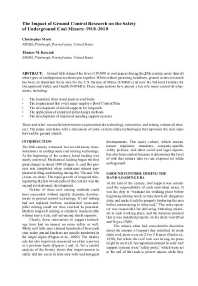Mining Publication: The Impact of Ground Control Research on the Safety of Underground Coal Miners: 1910-2010
Original creation date: January 2010
Ground falls claimed the lives of 50,000 us coal miners during the 20th century, more than all other types of underground accidents put together. While seldom garnering headlines, ground control research has been an important focus area for the U.S. Bureau of Mines (USBM) (and now the National Institute for Occupational Safety and Health (NIOSH)). These organizations have played a key role many central developments, including: the transition from wood posts to roof bolts; the requirement that every mine employ a Roof Control Plan; the development of shield supports for longwalls; the application of empirical pillar design methods; and the development of improved standing support systems. These and other successful interventions required that the technology, economics, and mining culture all intersect. The paper concludes with a discussion of some current safety technologies that represent the next steps forward for ground control.
Authors: C Mark, TM Barczak
Conference Paper - January 2010
NIOSHTIC2 Number: 20037756
Extracting the Science: A Century of Mining Research. Brune JF, ed., Littleton, CO: Society of Mining, Metallurgy, and Exploration, 2010 Jan; :177-188
See Also
- Diagnosing and Controlling Moisture-Sensitive Roof in Coal Mines
- Longwall Shield and Standing Gateroad Support Designs - Is Bigger Better?
- Optimizing Secondary Roof Support with the NIOSH Support Technology Optimization Program (STOP)
- Overview of Coal Mine Ground Control Issues in the Illinois Basin
- Pillar and Roof Span Design Guidelines for Underground Stone Mines
- A Retrospective Assessment of Longwall Roof Support with a Focus on Challenging Accepted Roof Support Concepts and Design Premises
- Sizing of Final Stumps for Safer Pillar Extraction
- STOP - Support Technology Optimization Program - 3.4
- Technology News 482 - Ground Support Safety Training Video
- Updating the NIOSH Support Technology Optimization Program (STOP) With New Support Technologies and Additional Design Features
- Page last reviewed: 3/13/2017
- Page last updated: 3/13/2017
- Content source: National Institute for Occupational Safety and Health, Mining Program


 ShareCompartir
ShareCompartir
